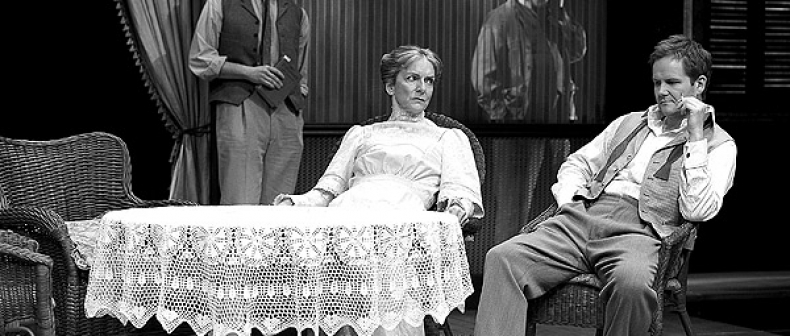
The roots of a family tree are powerful things. Depending on their temperament, they can keep a person grounded and stable, or choke them to death. But they run deep either way, and to properly capture their nuances and intricacies, a playwright needs to start digging.
That’s why Eugene O’Neill’s most celebrated play is also his most personal. The semi-autobiographical Long Day’s Journey Into Night is dark, haunting, and complicated in a way that only real life can be. The story of the Tyrone family is so heavily based on the American writer’s own family that he intended it not to be produced until 25 years after his death. And though the play opened about 22 years ahead of that deadline, it earned him the 1957 Pulitzer Prize for Drama.
Now, Soulpepper Theatre is airing out these familial skeletons once again in a new production directed by founding member Diana Leblanc, the woman responsible for the highly acclaimed 1994 production of Long Day’s Journey at the Stratford Festival (turned into a film two years later).
The play begins just after breakfast in 1912 at the summer home of the Tyrone family: James (Joseph Ziegler) and Mary (Nancy Palk) the husband and wife, with son Jamie (Evan Buliung), the eldest, and Edmund (Gregory Prest). As the parents and children seem to go their separate ways throughout the other eight months of the year–the parents moving from hotel to hotel, Edmund from ship to ship, and Jamie from bar to bar–they’ve always reconvened at the house in a small Connecticut town. At first glimpse the family seems to making strides after a series of traumatic events, but as the day progresses from morning to midnight, inescapable ghosts begin to resurface, while alcoholism, drug addiction, infidelity, jealousy, and present bitterness threaten their very survival.
Using such rich inspiration, O’Neill creates conflicted and complex characters that reveal themselves, or are revealed by another, layer by layer. Emotions turning 180 degrees within a single thought, they require an incredibly attentive cast, and if anyone in Toronto could handle this script it’s the Soulpepper company. Led by Leblanc, the cast throw themselves into the play’s darkness for an edited-down three hours, at their most bleak in a devastating second act. It’ll be an act of endurance if they can finish the play’s run without falling under the spell of O’Neill’s story for good.
As the heads of household, real-life partners Ziegler and Palk are heartwarming in their tender moments, which makes their subsequent verbal assaults all the more gut-wrenching. In her more unhinged moments, Palk’s morphine-addicted Mary is the stuff of horror films, switching moods from an aging crone to an innocent girl, literally embodying the phantom of her former self in the final scene. Ziegler is a softer James than usual, but that emphasizes his inability to curb his miserly ways, even though he knows it’s wedging a gorge between him and his sons.
If children are the future, Buliung and Prest don’t present a pretty one in Jamie and Edmund. Jamie is the family’s black sheep, a man who lives off women and booze, disgracing the family and constantly being reminded of it by his father, and Buliung renders him sensitively despite the bitterness. He’s endearing even when explaining his night with a prostitute in a drunken stupor, a lacey tablecloth draped over his head.
But Prest, in the role of O’Neill himself, provides arguably the most impressive performance of the show as Edmund, an ill young man caught between his father’s love of poetry and the stage and his brother’s love for drink, who learns that trying to combine the two is a losing battle. Capable of a few stinging one-liners himself, he comes off as the biggest victim of the family’s dynamics, a fact he’s aware of and bears with biting dark humour.
Piecing everything together is Leblanc’s direction, which never lets the audience forget the love intrinsic within the Tyrone family. Peter Hartwell’s set design transforms all of the characters into blurred shades of themselves; the transparent façade of the home’s hallway is a hazy yet impenetrable barrier, just like that which prevents the Tyrone family from truly connecting.
____
Carly Maga is an arts writer in Toronto. Follow her on Twitter at @RadioMaga.
For more, follow us on Twitter at @torontostandard, and subscribe to our newsletter.














